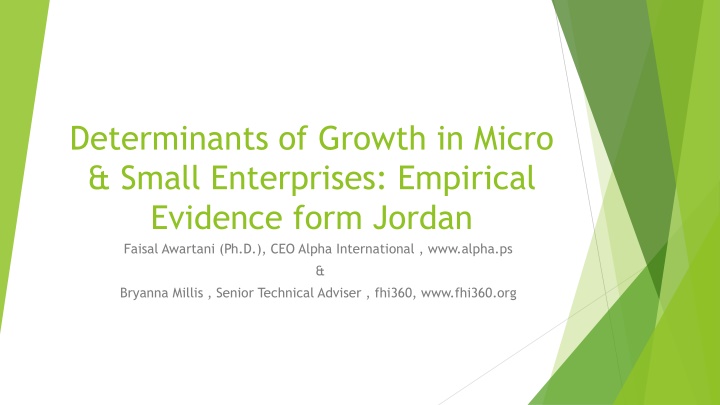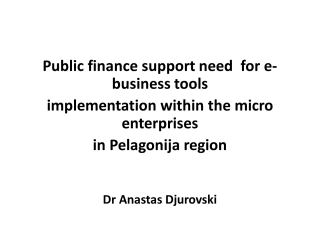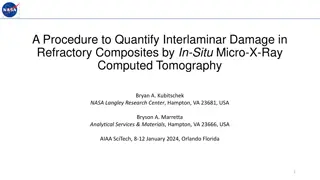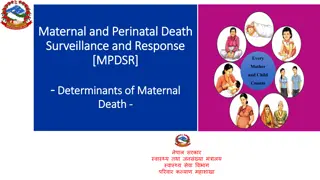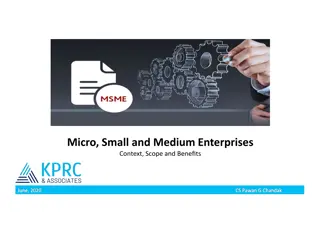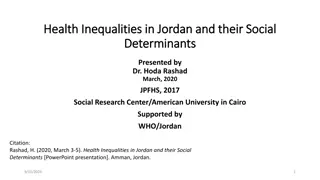Determinants of Growth in Micro & Small Enterprises: Empirical Evidence from Jordan
Jordanian micro and small enterprises (MSEs) play a significant role in the economy but face challenges in accessing markets and obtaining finance. A research study was conducted in Jordan to analyze the factors influencing the growth of MSEs, including formality, education level of owners, technology use, age of firms, inter-firm cooperation, gender of owners, and social networks. The study utilized multivariate logistic regression analysis to identify the significant factors impacting growth, with most variables showing a significant relationship except for gender of owners and social networks.
Download Presentation

Please find below an Image/Link to download the presentation.
The content on the website is provided AS IS for your information and personal use only. It may not be sold, licensed, or shared on other websites without obtaining consent from the author.If you encounter any issues during the download, it is possible that the publisher has removed the file from their server.
You are allowed to download the files provided on this website for personal or commercial use, subject to the condition that they are used lawfully. All files are the property of their respective owners.
The content on the website is provided AS IS for your information and personal use only. It may not be sold, licensed, or shared on other websites without obtaining consent from the author.
E N D
Presentation Transcript
Determinants of Growth in Micro & Small Enterprises: Empirical Evidence form Jordan Faisal Awartani (Ph.D.), CEO Alpha International , www.alpha.ps & Bryanna Millis , Senior Technical Adviser , fhi360, www.fhi360.org
Jordanian Context MSE s count for 99% of firms in Jordan (Department of Statistics, 2011) MSE s make 50% of Jordanian GDP, and 45% of Exports MSE s employ 71% of Private sector workforce in Jordan, and can be said to be the largest contributor to job creation. Nevertheless, MSE s in general, have more difficulty Accessing market Obtaining finance, Taking risks with product innovations or business processes As such, many MSE s operate at a survivalist level, and do not contribute significantly to job creation or economic growth.
Research Design 1) Sample & Statistical Modelling Selection through two-stage cluster of targeted governorates by USAID- Funded Local Enterprise Support LENS Total of 4,721 MSE s (enterprise with 1-19 Employees) from East Amman, Zarqa, Irbid, Karak, Tafleh, and Aqaba 2) Dependent Variable The dependent variable is Growth, which was measured in terms of hiring new employees within the past year
Research Design 3) Independent Variables Formality : Business Registration with the Ministry of Industry & Trade Education Level of Owner Sector Use of Technology Age of Firm Inter-Firm Cooperation: Cooperation between firm and buyers/suppliers or other similar firms. Gender of Owner Social Networks
Study Model A Multivariate logistic regression model was used to calculate the significance of the independent variables to the dependent variable, Growth. An odds ratio (OR) was also calculated to help understand the effects of certain variables on the dependent Variable, and also rank the importance of factors in relation to their effect on the dependent variable. Cross Tabulation was used for further understanding of the independent variables and their relation to the dependent Variable.
Results Multivariate Logistic Regression Analysis was used to calculated the significance of each factor (independent variable) to Growth 1. Most factors show a significant relationship between them and growth, where P-value was 0 for all except two. 2. The two factors which show no significance in terms of P-value are Gender of Owner, & Social Networks this is because Gender of owner is highly related to Formality, where male-owned MSEs whom are formally registered are twice as many as female-owned MSE s Social Network lost significance due to is high correlation to both Education Level of Owner & Formality of business.
Results Odds Ratio, showing the likelihood of MSE growth as a result of a specific factor had the following results listed by relative importance Formality shows a 3:1 ratio, meaning business whom are formally registered are three times likely to grow than those not registered. 1. Education Level, 2:1 ratio, those with BA or higher are twice as likely to grow than those with lower education levels. 2. Sector, Manufacturing sector has a 2:1 ratio, meaning those within this sector are twice as likely to grow than those within Retail & Trade 3. Use of Technology, 2:1 ratio 4. Inter-Firm cooperation, those who cooperate have a ratio of 1.8:1 5. Age of firm, younger firms (those registered after 2010) have a ratio of 1.5:1, meaning that younger firms are 1.5 times more likely to grow than those registered before 2000 6.
Conclusion & Recommendations The research above identifies the main factors relative to MSE growth, and the degree of their effect on it. This can be used in multiple ways, such as: 1. Donors, International and National, can use the study above to aim their projects to improve or increase certain factors that ultimately effect MSE growth. For example, targeting business registration of MSE s, will have a good positive impact on MSE growth. 2. The model can be used identify High Growth Potential MSE s. Helping micro- finance institutes and banks to create a growth scoring system to target MSE s with a high probability to grow. This can help risk reduction on the financers end.
